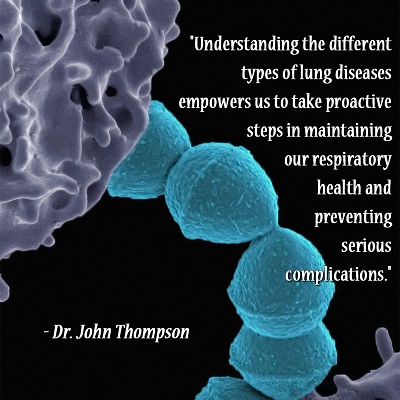 Did you know that lung diseases are among the most common medical conditions worldwide? That’s really not surprising considering how important our lungs are. If they’re not healthy we certainly suffer, and there are many people who’s lives are affected by a chronic respiratory condition.
Did you know that lung diseases are among the most common medical conditions worldwide? That’s really not surprising considering how important our lungs are. If they’re not healthy we certainly suffer, and there are many people who’s lives are affected by a chronic respiratory condition.
Lung diseases can be categorized into three main types as described below.
Airway Diseases
Airway diseases affect the airways or tubes that carry oxygen into our lungs. The airways become narrow or blocked, making it difficult to breathe. The common symptoms include a chronic cough, shortness of breath, wheezing, chest tightness, excess mucus production, and frequent respiratory infections.
This type of lung disease is one you may be familiar with. They include the following conditions:
Asthma
This is a chronic condition that causes the airways to become inflamed and narrow. It can be triggered by allergens, exercise, and stress.
Chronic Obstructive Pulmonary Disease (COPD)
COPD includes emphysema and chronic bronchitis. COPD blocks the airflow and causes breathing-related problems, such as a chronic cough. It affects adults, with cigarette smoking being the primary cause. It becomes worse over time, making patients feel breathless.
Bronchitis
This is a condition where your bronchial tubes are inflamed.
Bronchitis can be acute (short-term) or chronic (long-term), and is often due to infections or smoking.
Managing Symptoms of Airway Diseases
This may involve multiple approaches. Medications prescribed by your doctor, such as inhalers, bronchodilators, and steroids may be used to open airways and reduce inflammation.
It’s also important to identify and avoid allergens or irritants that trigger symptoms, especially for asthma. This is where making lifestyle changes like quitting smoking, staying active, and maintaining a healthy diet can also help manage symptoms.
Lung Tissue Diseases
This particular lung disease affects the tissue and space around the air sacs of the lungs. There may be scarring or inflammation of the lung tissue, so the lungs can’t expand fully. As a result, it’s hard to get enough oxygen, and it’s also difficult to release carbon dioxide. You can’t take deep breaths, so you feel restricted in your chest area.
There are quite a few lung tissue diseases, however, here are some of the more common ones:
Asbestosis
We are probably all aware of this one. This disease is caused by inhaling asbestos fibers, leading to lung tissue scarring and breathing difficulties.
Silicosis
This lung disease is caused by inhaling silica dust. This leads to inflammation and scarring of the lung tissue.
Pulmonary Fibrosis
This disease is where the lung tissue is scarred and stiff, so it’s difficult to breathe. It also leads to decreased oxygen levels in the blood. This disease may be due to exposure to certain chemicals or medical conditions. Sometimes, it’s hard to know the cause.
Pulmonary Sarcoidosis
When sarcoidosis affects the lungs, it is known as pulmonary sarcoidosis. This can lead to symptoms such as a persistent cough, shortness of breath, chest pain, and wheezing. The exact cause of sarcoidosis is unknown, but it is believed to involve an abnormal immune response.
Managing Symptoms of Lung Tissue Diseases
Managing symptoms of lung tissue diseases typically begins with medications aimed at reducing inflammation and slowing down the disease. Oxygen therapy is another treatment used for patients with low blood oxygen levels, so too is pulmonary rehabilitation, which includes a program focused on exercise, education, and support.
Of course, lifestyle changes can significantly impact the management of lung tissue diseases. Adopting a healthy lifestyle by avoiding smoking, staying active, and eating a balanced diet can all contribute to the management of symptoms.
Lung Circulation Diseases
Lung circulation diseases affect the blood vessels in the lungs, causing clotting, scarring, or inflammation. They can impact the flow of blood between the heart and lungs, leading to problems with blood oxygenation. Common lung circulation diseases include the following.
Pulmonary Hypertension
This disease involves ‘hypertension’ or high blood pressure in the arteries of the lungs, causing the heart to pump blood harder. Over time, this increased effort can lead to right heart failure as the heart has to work harder to pump blood through the narrowed arteries.
Pulmonary Embolism
This disease occurs when a blood clot travels to the lungs and blocks one of the arteries. This can cause sudden chest pain, shortness of breath, rapid heart rate, and in severe cases, can be life-threatening. As with any clot moving through the body, medical treatment is essential to dissolve the clot and restore blood flow as soon as possible.
Pulmonary Edema
This disease involves the abnormal accumulation of fluid in the lungs due to issues with the circulatory system. This fluid buildup in the air sacs of the lungs makes it hard to breathe. This condition is often related to problems with the heart or blood vessels, which affect the normal movement of blood through the lungs and lead to fluid leakage into the alveoli. This condition can be caused by heart problems, pneumonia, or exposure to certain toxins.
Managing Symptoms of Lung Circulation Diseases
To manage symptoms, a combination of medications is often used. These help regulate blood pressure, reduce fluid buildup, and prevent blood clots. Again, supplemental oxygen therapy might be necessary, and lifestyle changes are recommended too!
If you experience any issues with your lungs at all, go and see your health care professional.
As you can see there are so many diseases that can affect the health of your lungs. Taking care of your respiratory health is essential for overall well-being, and knowledge about the different types of lung diseases helps you take better care of your health.






